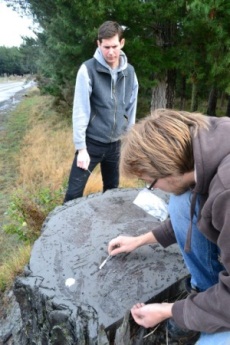The Eruption of Mount Tongariro - a Volcanologists Perspective
Shortly before midnight on August 6, 2012, Mount Tongariro erupted for the first time in 115 years after a short period of increased seismicity. Ash samples were immediately distributed among researchers from all New Zealand Universities and GNS

Shortly before midnight on August 6, 2012, Mount Tongariro erupted for the first time in 115 years after a short period of increased seismicity. The eruption included an unknown number of initial blasts, which ejected blocks of the pre-existing hydrothermal caprock to distances of about 1.8-2 km, including some that crashed through the roof of the popular Ketatahi hut. Initial blasts were followed by a higher plume of fine ash that was dispersed as far East as Gisborne. To the delight of central North Island residents (and tempered chagrin of young volcanologists) the eruption ended nearly as quickly as it began.
Ash samples were immediately distributed among researchers from all New Zealand Universities and GNS, with the goals of characterizing the eruption, and evaluating any continued risks.
Once it was established that there were no immediate health and safety concerns from the ash: namely that it was not interfering with electricity transmission, and was not introducing harmful levels of toxins (e.g., fluorine) into water supplies, the scientific community began quick analysis and lively debate about the nature of the eruption.
One key question was whether or not the eruption had been triggered by the arrival of fresh magma to shallow enough levels that it began to interact with the existing hydrothermal system.
Evidence for magma included heightened magmatic gas emissions (SO2, CO2) following the eruption; evidence against was that there was only trace, equivocal evidence for a juvenile component in the ash itself.
The work required to fully characterize and understand the causes of the Tongariro eruption, and in turn to make predictions about any activity in the near future, is ongoing, and includes the need to thoroughly examine the proximal ejecta. Initial interpretations of geophysical data and examination of the ash itself was necessarily rushed by civil defence’s need to ascertain immediate hazards, and the media’s dualistic demand for both scientifically sound answers and engaging front-page news.
At the time of writing, it remains to be seen if this is the first in a series of eruptions to follow, or if it was a small one-off reconfiguration of the shallow hydrothermal field. However, even if the latter turns out to be true, the eruption is by no means insignificant. For New Zealanders, it is a reminder that the picturesque Taupo Volcanic Zone is very much an active volcanic system; ash on the ground being more tangible than the comparatively inaccessible evidence given in scientific journal articles, cryptic seismic anomalies, or reports from remote locations such as White Island. Furthermore, it has afforded the volcanological community an opportunity to have a relatively inconsequential “practice run” for eruption response. Lessons learned and collaborations created in the handling of Tongariro 2012 will be invaluable in the mitigation of future eruptions, which are inevitable from the active volcanoes of New Zealand.
